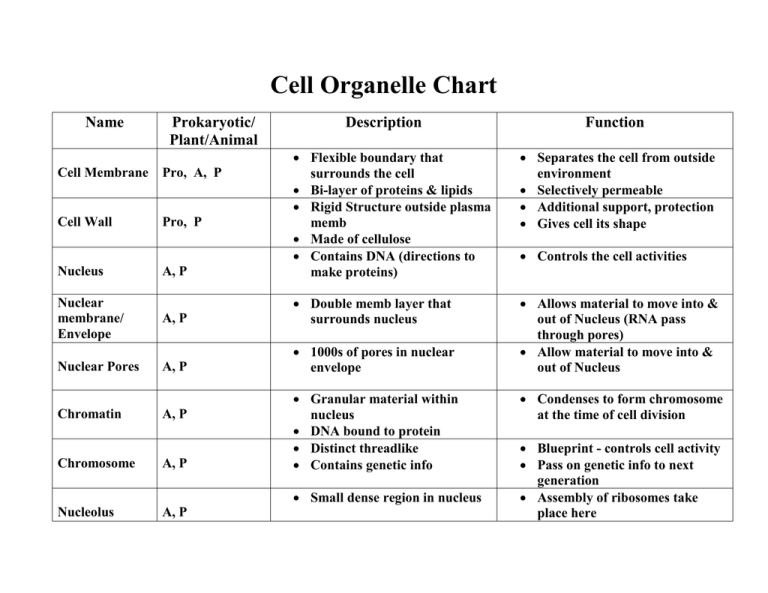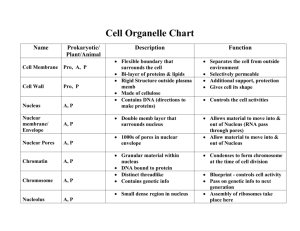Cell Organelle Chart Name Prokaryotic/ Description
advertisement

Cell Organelle Chart Name Prokaryotic/ Plant/Animal Description Function Separates the cell from outside environment Selectively permeable Additional support, protection Gives cell its shape A, P Flexible boundary that surrounds the cell Bi-layer of proteins & lipids Rigid Structure outside plasma memb Made of cellulose Contains DNA (directions to make proteins) A, P Double memb layer that surrounds nucleus Nuclear Pores A, P 1000s of pores in nuclear envelope Allows material to move into & out of Nucleus (RNA pass through pores) Allow material to move into & out of Nucleus Chromatin A, P Cell Membrane Pro, A, P Cell Wall Pro, P Nucleus Nuclear membrane/ Envelope Chromosome A, P Granular material within nucleus DNA bound to protein Distinct threadlike Contains genetic info Small dense region in nucleus Nucleolus A, P Controls the cell activities Condenses to form chromosome at the time of cell division Blueprint - controls cell activity Pass on genetic info to next generation Assembly of ribosomes take place here Cytoplasm Cytoskeleton Cilia/ Flagella Pro, A, P Clear Gelatinous(jelly) fluid inside the cell Chemical reactions take place here Network of protein filaments Helps the cell to maintain its shape & 3 D structure Cell movement Cell Movement A, P A Short/long projections of microtubules Hollow tubes of protein Microtubule A, P Long thin fibers Microfilament A, P Tiny , abundant Made of RNA & Protein Site of protein synthesis Ribosome Pro, A, P Endoplasmic Reticulum A, P Highly folded memb in cytoplasm 1. Rough E.R. (ribosome) 2. Smooth E.R. (no ribosomes) A, P Flattened stack of tubular memb Found near cell memb Golgi Apparatus Maintain cell shape Form cilia/flagella Separate chromosomes in cell division Maintain cell shape Cell movement & support Connects membrane Moves material Process protein Smooth E.R. – production & storage of carbs & lipid Sorts & packs protein into vesicle & transports them Lysosome Vacuole Mitochondrion Centrioles/ Basal bodies Chloroplast Contains digestive enzymes Digests food, bacteria, worn out organelle Sac (membrane bound) Stores food, enzyme, and other material Support Power house of cell – produces energy for growth, development, and movement Helps in cell division (mitosis) A P, A (small or none) A, P A P Double membrane bound organelle Small structure outside nucleus formed from microtubules Double membrane bound organelle Pigment chlorophyll is present in inner menb Captures light & converts it into chemical energy Pigment chlorophyll (photosynthesis) Prokaryotic cells Eukaryotic Cells DO NOT contain membrane bound organelle. Contain membrane bound organelle. Metabolism takes place in cytoplasm Ex Bacteria Different parts of the cells perform different functions Complex structure 100 times bigger than prokaryotic cell Mostly multicellular Exception is Amoeba, Yeast Ex higher plants and animals. No nucleus DNA is circular Nucleus holds DNA DNA is linear Simple structure Smaller Unicellular









